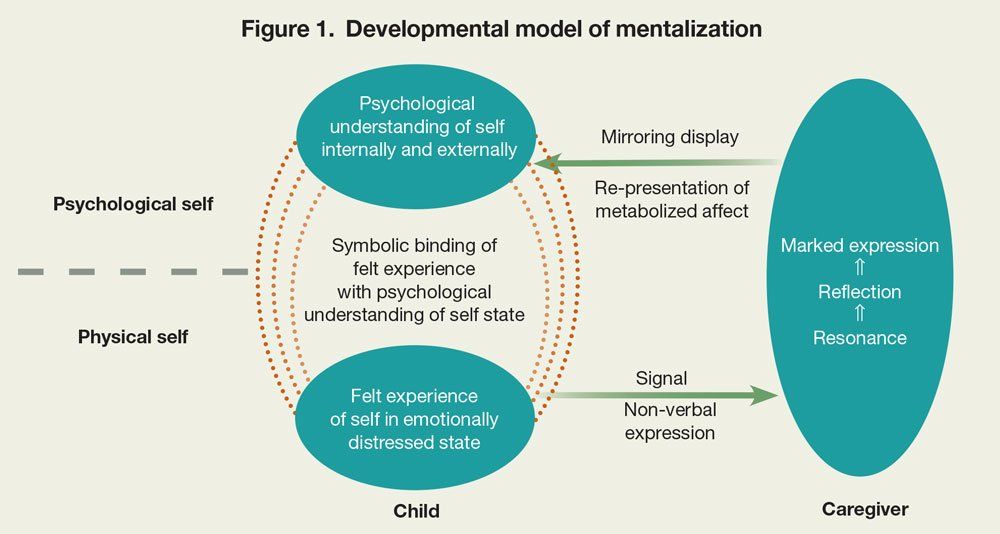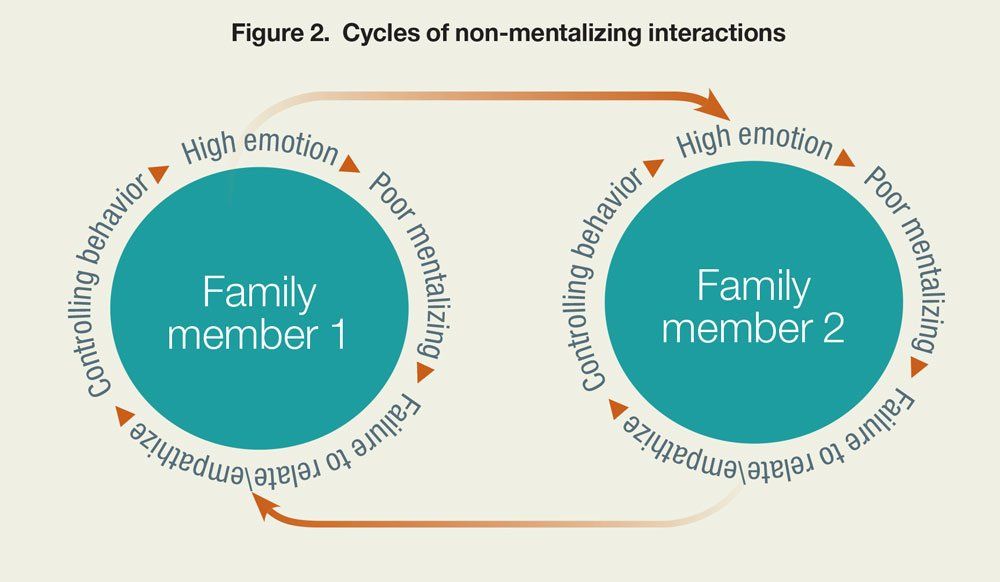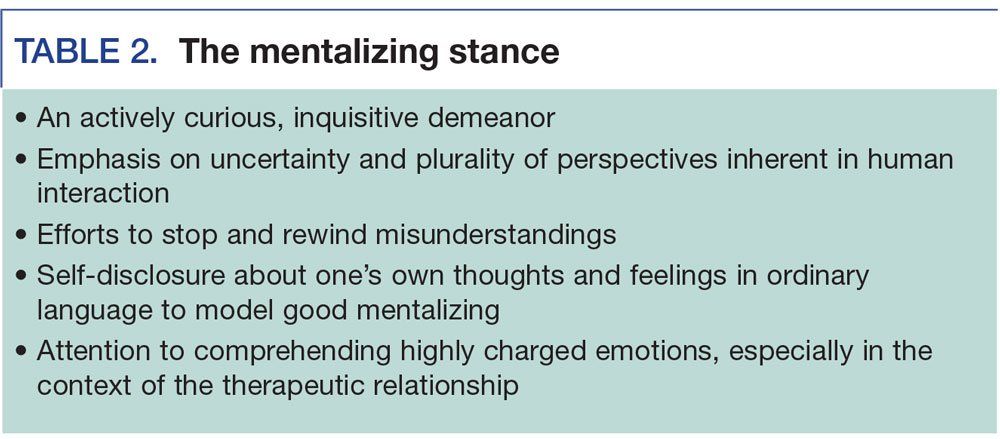Publication
Article
Psychiatric Times
Mentalization-Based Treatment: A Common-Sense Approach to Borderline Personality Disorder
Author(s):
MBT presents a compromise to bridge the valuable history of psychoanalytic ideas to both modern psychiatric research as well as present public health needs and practice.
Figure 1. Developmental model of mentalization

Figure 2. Cycles of non-mentalizing interactions

TABLE 1. Clues for detecting prementalization states

TABLE 2. The mentalizing stance

Mentalization-based treatment (MBT) is an evidence-based psychotherapeutic approach for borderline personality disorder. MBT is derived from both traditional psychoanalytic concepts and new discoveries from attachment and social cognition research. Mentalization simply describes the common psychological process that people use to understand mental states (ie, emotions, beliefs, desires-intentions that underlie interpersonal interactions). It covers a wide territory of psychological activity that determines the way people manage their emotions and thoughts coherently; effectively respond to their own experience and that of others; maintain satisfying relationships; and understand themselves, thereby stabilizing their sense of self (ie, identity). The stability, flexibility, benevolence, and honesty with which people mentalize underpins how their psychology works, or how their personality functions. Mentalization therefore lies at the root of psychological health and resilience as a common process relevant to all psychotherapies.
Pros of MBT
MBT’s simple, common-sense approach has practical advantages over dialectical behavioral therapy (DBT). Those who use MBT need little formal training to be effective.1,2 DBT requires skills coaching, a skills training curriculum with numerous handouts and worksheets, weekly individual therapy, and a consultation team to support therapists.
DBT formulates borderline personality disorder as a problem of emotional dysregulation and lack of skills to manage distress and relationships. MBT centralizes instability of attachment and its developmental byproduct, mentalization, as the core dysfunction. Fonagy and Allison3 extended the formulation of borderline personality disorder and personality disorders in general as a problem of epistemic trust, the capacity to “trust in the authenticity and personal relevance” of information presented in an interpersonal context. This revised notion explains the rigidity of thinking that individuals with borderline personality disorder (as well as those with other personality disorders) have with interpersonal relationships. Because of a tendency toward epistemic mistrust, individuals with borderline personality disorder have difficulty learning and changing despite repeated patterns of painful interpersonal problems and efforts by others to teach them how to manage less destructively.
According to attachment research and theory, infants activate attachment by communicating emotional distress to their caretakers. When all goes well, the caretaker responds in a way that re-regulates the infant. The first step of the optimal caretaking response is to recognize the infant’s distress and then reinstate confidence with soothing and optimistic encouragement to explore the environment (ie, via a secure base). Secure attachment facilitates self-regulation in terms of emotions, attentional control, and behavior. Early attachment also provides a template for expectations of oneself and others in relationships.
Secure attachment embodies a developmental process whereby the caretaker manages to reasonably imagine and interpret the mental states of the child, responding in a way that helps the child understand and manage his or her own distress. This is the process by which secure attachment facilitates the development of mentalization (Figure 1). For example, when a child falls and bursts into tears, a caretaker may respond in a marked contingent way with a sympathetic frown, underpinned by the idea “Poor baby, you fell and are hurt and scared.” An unmarked response might involve the caretaker actually mirroring the child and crying in distress. A noncontingent response would be completely nonresonant with the child’s experience: for example, an angry response with underlying cognitions such as “Why do you have to be so clumsy?”
If the caretaker is able to provide marked and contingent mirroring when the child is emotionally distressed, the child begins to develop a coherent sense of his own experience. This kindles the child’s ability to mentalize, allowing him to begin to understand the relationship between actions and mental states in an interpersonal interaction. This process ultimately becomes the basis of epistemic trust, which provides an openness to learn from others in a relational process. (See Bateman and Fonagy4 for a review of empirical data that support this model.)
The attachment styles most common in borderline personality disorder include preoccupied, fearful, and disorganized types that combine oscillatory, dependent, mistrustful, hostile, and incoherent features. The individual with borderline personality disorder has a tendency to engage (or make attachment bids to) others with disorganized, confusing, and controlling strategies, which in turn elicits disorganized, confusing, controlling tendencies in return.
This attachment transaction not only fails to regulate and re-establish a sense of safety, but also creates additional distress, increasing vulnerability and need in the child as well as the risk of dysregulation and burnout in the caretaker. As depicted in Figure 2, this vicious cycle of distress and ineffective attachment functioning leads to a “hyperactivated” attachment, in which mentalizing in both child and caretaker is likely to be overwhelmed in favor of behavioral means of communication and problem solving.
The MBT technique
While the clinical theories and neuroscientific evidence integrated in MBT’s formulation of borderline personality disorder are sophisticated, the techniques involved in MBT are simple and direct. At the base of the mentalizing stance is a position of curiosity, of being interested in exploring different perspectives of the patient’s experience both in relationships outside treatment and with the therapist. The job of the therpista is to encourage patients to mentalize, rather than do it for them by providing interpretations or by instructing them on how to manage behavior or distress. The only agenda is to sustain the mentalizing process to optimize the patient’s capacity to arrive at autonomous insight or behavioral change.
Mentalization is prone to go offline in situations of stressful arousal (eg, intense emotion) and hyperactivated attachment. The MBT therapist intervenes when mentalizing becomes compromised. Detecting prementalistic states (Table 1) prompts the clinician to recognize that the patient is unlikely to be able to understand her or others’ mental states realistically, benevolently, or flexibly. The clinician uses MBT techniques to broaden and thereby stabilize the patient’s capacity for empathy. According to this model, a common mistake in psychotherapeutic practice is to assume that the patient can mentalize when emotionally activated. Offering complex interpretations or behavioral plans when the patient is too vulnerable is useless because the patient is incapable of trusting the therapist or of making use of any interventions.
MBT assessment and treatment structure
MBT begins with assessment and formulation of the patient’s problems and treatment goals within a mentalizing framework. The therapist and patient collaboratively explore presenting problems to establish joint attention to a shared understanding of the therapeutic work. This first step provides a secure base from which issues can be addressed as treatment unfolds.
Assessment of the patient’s overall mentalizing capacities starts with inviting a general account of problems that were the catalyst to seek treatment. Particular attention is paid to how breakdowns in mentalizing are linked to suicidal or self-destructive behaviors, and these vulnerability points are targeted as a central focus in the treatment. The therapist explores the patient’s capacity to maintain and recover mentalizing when challenged by emotionally laden interpersonal events, such as misunderstandings, disagreements, rejections (real or perceived), or intensification of intimacy. Important developmental events and attachment figures, past and present, are discussed to elucidate how robustly a person can mentalize within close relationships and where this capacity breaks down.
While probing these areas, the therapist scans for spontaneous descriptions of particular nonmentalizing modes that are overly disconnected from emotion (pretend mode), unreasonably certain (psychic equivalence: “I worry I can’t manage being alone; therefore, I can’t”), or concrete (teleological mode: “He doesn’t like me because he didn’t call me back right away”). Poor mentalizing is seen when extremes arise in the patient’s focus and the therapist intervenes with “contrary moves.” The patient is invited to incorporate the missing vantage point into a more balanced perspective, which allows assessment of the patient’s ability to broaden overly rigid, reactive, unrealistic, or emotionally vacant perspectives.
The initial assessment yields a general understanding of how presenting problems stem from fluctuations in mentalizing capacities related to the level of emotional arousal and attachment system activation. The therapist summarizes her findings in an openly shared, plainspoken manner. Patients are asked to think about and revise the formulation of emotional and relational patterns, to foster an ever-evolving and enhanced self-understanding. The initial phase of treatment also incorporates an explanation of the appropriate diagnosis and psychoeducation about concepts of mentalization, evolutionary functions of basic emotions, attachment styles, and the relevance of mentalizing for treatment.
Within structured MBT programs, an 8- to 12-week introductory MBT group is the primary vehicle for providing psychoeducation and pre-treatment engagement for patients who are considering or entering the program. This preliminary group segues into a longitudinal weekly MBT group that runs parallel to weekly individual therapy sessions. Patients are informed that individual and group therapists-in addition to psychiatrists who provide medication management and any other team members-meet regularly as a group to review case formulations, progress, and challenges arising in treatment as well as to expand clinicians’ individual perspectives on each patient through the collective mentalizing of the treatment team.
Basic mentalizing stance and hierarchy of interventions
For patients in a position of epistemic mistrust, therapeutic attempts aimed at probing, sympathetic support, and self-reflection can inadvertently destabilize mentalization by escalating emotional arousal and hyperactivating insecure or disorganized attachment processes. These iatrogenic disruptions are minimized by deploying a basic mentalizing stance that serves as a “secure base” from which the therapist promotes good mentalizing and facilitates its recovery when it is lost (Table 2).
Therapists monitor the levels of mentalizing, emotional arousal, and attachment activation as they fluctuate over the course of the session. The aim is to stimulate just enough emotional responsiveness so that the exploration of new perspectives becomes meaningful, but not so much that mentalizing collapses due to unmanageable arousal.
As the treatment progresses, MBT carefully balances support strategies to develop the appropriate levels of trust and emotional arousal needed for good mentalizing. Initially, supportive strategies with empathic validation maneuvers are used to clarify and elaborate the patient’s perspectives. More challenging interventions help patients make sense of emotional undercurrents and relational dynamics implicit within the therapeutic relationship, which generally reflect similar dysfunction in relationships outside of treatment.
Adherence to the MBT model is enhanced by the therapist’s affect focus, frequent use of challenge, and integration of patients’ experiences across individual and group sessions. For example, imagine a patient who describes a situation in which she yelled at her child and felt guilty about it. In the session, the patient seems anxious and hypervigilant to the therapist’s response. The therapist would focus on the affect the patient experiences about how the therapist is mentalizing about her. This helps the patient understand not only her own affect but also her experience of talking about what is on her mind in the presence of another person. The therapist develops an inquiry and exploration in vivo, so the patient can conceptualize and express her affect within the interpersonal context. The ultimate goal of MBT is not merely to broaden patients’ perspectives on particular relational events, but to expand their reflective receptivity to new learning in interpersonal contexts outside of treatment.
Conclusions
MBT is an integrative treatment approach for borderline and other severe personality disorders. It combines ideas from both psychoanalysis and modern research and is based on the unique human capacity to mentalize, or understand mental states underlying one’s own actions as well as those of others. MBT appears to be widely applicable to various types of patients, at different developmental stages and with psychiatric diagnoses. It has been adapted and empirically validated in an adolescent format (MBT-A) and modified to treat eating disorders, depression, PTSD, and antisocial personality disorder.5
Public health interests to augment access to care inform our view that MBT should be taught to trainees of various clinical disciplines, especially psychiatry residents, as a psychotherapy approach to treating “difficult to reach” patients with personality disorders. As the empirical basis for psychoanalytic treatment of most major psychiatric disorders remains slim and the demands for psychoanalytic training remain lengthy and time consuming, MBT presents a compromise to bridge the valuable history of psychoanalytic ideas to both modern psychiatric research as well as present public health needs and practice.
Disclosures:
Dr Choi-Kain is Director of the Adult Borderline Center and Training Institute at the McLean Hospital in Belmont, MA; she is also Medical and Program Director and Dr Unruh is Assistant Medical Director at McLean Gunderson. Dr Choi-Kain reports that she is Course Director and receives royalties from HMS Continuing Education, and she receives royalties from Springer as author and editor of Borderline Personality and Mood Disorders. Dr Unruh reports no conflicts of interest concerning the subject matter of this article.
References:
1. Bateman A, Fonagy P. Effectiveness of partial hospitalization in the treatment of borderline personality disorder: a randomized controlled trial. Am J Psychiatry. 1999;156:1563-1569.
2. Bateman A, Fonagy P. Health service utilization costs for borderline personality disorder patients treated with psychoanalytically oriented partial hospitalization versus general psychiatric care. Am J Psychiatry. 2003;160:169-171.
3. Fonagy P, Allison E. The role of mentalizing and epistemic trust in the therapeutic relationship. Psychotherapy. 2014;51:372-380.
4. Bateman AW, Fonagy P. Handbook of Mentalizing in Mental Health Practice. Arlington, VA: American Psychiatric Publishing; 2012.
5. Rossouw TI, Fonagy P. Mentalization-based treatment for self-harm in adolescents: a randomized controlled trial. J Am Acad Child Adolesc Psychiatry. 2012;51:1304-1313.






